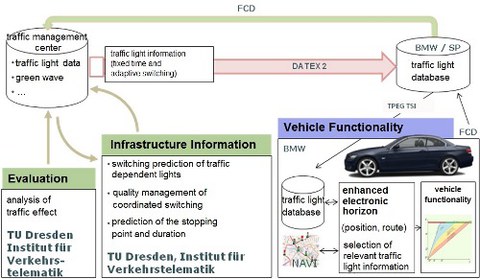EFA 2014
Logo of the project EFA 2014 Project Description: EFA 2014 - Energy-Efficient Private Transport (Energieeffizientes FAhren) Funding: Federal Ministry of Education and Research (Bundesministerium fuer Bildung und Forschung) Project management: BMW AG Project coordinator: BMW AG Project partner:
- Daimler AG
- BMW AG
- Robert Bosch GmbH
- Hella KGaA Hueck & Co.
- Harmann/Becker Automotive Systems
- Continental Automotive GmbH
- Forschungsinstitut fuer Kraftfahrwesen und Fahrzeugmotoren Stuttgart
- FZI Forschungszentrum Informatik
- Infineon Technol. AG
- Elmos Semiconductor AG
- metaio Augmented Solutions GmbH
- Bayrisches Zentrum für Angewandte Energieforschung
- Valeo
- Reo AG
- Stadt Dresden
Responsible:
Project duration: 04-01-2012 - 06-30-2014
Project description
Braking and acceleration at traffic lights cause high energy consumption. Especially for electric vehicles, this excess consumption reduces their coverage radius greatly and thus reduces the attractiveness of the electric mobility.
In the research project EFA 2014/2, following aspects are investigated from the point of increment of coverage:
- avoidance of braking and acceleration processes at traffic lights
- intelligent route selection
- optimization of the operating strategy
The successful implementation of these points not only requires highly accurate maps, whose information content exceeds the current cards. The phase change of the traffic lights also must be available in the vehicle. Therefore, a reliable and fast communication must be ensured between the infrastructure and the vehicles.
Test vehicle with GSM and GNSS antennas for data transmission and positioning, as well as a camera to detect the traffic lanes. Further information on the test vehicle is available at BMW.
Tasks of ITVS
- accurate localization of the test vehicle
- creating a highly accurate map, which contains individual lanes and the associated signal generator
- development of sensor data fusion algorithms
- implementation of sensor data fusion algorithms on the test vehicle
- reproduction of the data transmission path in the laboratory
- latency measurement between the traffic management center and the test bed
- monitoring of mobile communication link quality along the verification route
- test of data transmission in various scenarios and statistical analysis
Overview on data transmission (infrastructure to vehicle)



